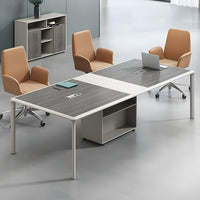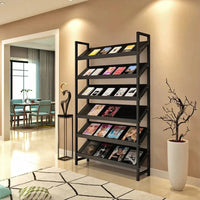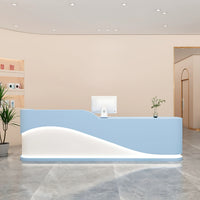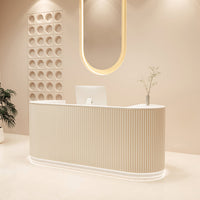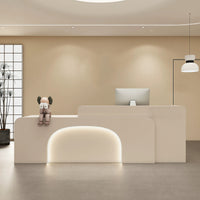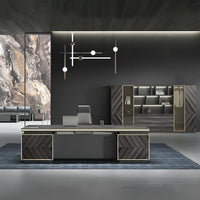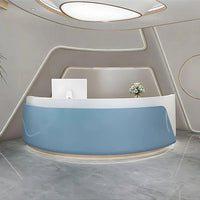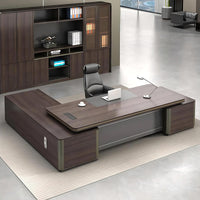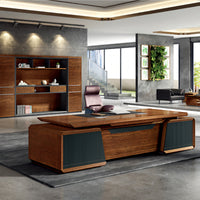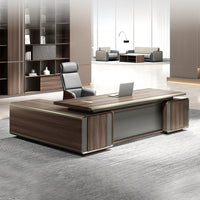Reception Desks vs Office Desks: What’s the Real Difference?
kaguyasuContent Menu
● What is a Reception Desk?
>> Definition and Purpose
>> Design Characteristics
● What is an Office Desk?
>> Definition and Purpose
>> Design Characteristics
● Key Differences Between Reception Desks and Office Desks
● Functional Considerations
>> Interaction and Accessibility
>> Ergonomics and Flexibility
● Design and Aesthetic Impact
>> Reception Desk Styles
>> Office Desk Styles
● Space and Setup Requirements
● Cost Considerations
● Conclusion
● Related Questions and Answers
In any professional environment, furniture plays a crucial role in shaping both functionality and aesthetics. Among the most essential pieces are desks, which come in various forms tailored to specific purposes. Two common types that often cause confusion are reception desks and office desks. While they may appear similar at first glance, their design, purpose, and features differ significantly. This article explores the real differences between reception desks and office desks, helping businesses choose the right furniture to enhance their workspace efficiency and visitor experience.

What is a Reception Desk?
Definition and Purpose
A reception desk is a specialized desk located at the entrance or lobby of an office or business. Its primary function is to serve as the first point of contact for visitors, clients, and customers. Reception desks are staffed by receptionists who manage visitor check-ins, answer inquiries, and sometimes handle administrative tasks. Because of this front-facing role, reception desks are designed not only for functionality but also to create a strong and positive first impression.
Design Characteristics
Reception desks tend to be larger and more prominent than typical office desks. They often feature:
- A raised counter or ledge facing visitors, providing a comfortable height for guest interactions.
- A lower working surface behind the counter for the receptionist to perform tasks such as computer work, phone handling, and paperwork.
- An inviting and stylish appearance, often customized to reflect the company's brand or aesthetic, ranging from traditional wood finishes to sleek, modern materials like glass and metal.
Reception desks come in various styles, including traditional, contemporary, L-shaped, and curved designs, each suited to different business atmospheres and spatial requirements.
What is an Office Desk?
Definition and Purpose
An office desk is designed primarily for individual workspaces within an office. It supports daily tasks such as writing, computer work, meetings, and document management. Unlike reception desks, office desks are intended for use by employees rather than visitors.
Design Characteristics
Office desks are generally more compact and functional. Their features include:
- A flat work surface optimized for productivity.
- Storage options such as drawers, file compartments, or shelves for organizing work materials.
- Various shapes including rectangular, L-shaped, and corner desks to fit different office layouts.
- Designs that prioritize ergonomics and comfort for prolonged use, often paired with office chairs.
Office desks tend to blend into the workspace environment without drawing undue attention, focusing on practicality over aesthetics.
Key Differences Between Reception Desks and Office Desks
| Feature | Reception Desk | Office Desk |
|---|---|---|
| Primary Function | First point of contact; visitor interaction | Individual workspace for employees |
| Location | Entrance, lobby, or reception area | Employee offices or cubicles |
| Design Focus | Aesthetic appeal and welcoming presence | Ergonomics and productivity |
| Size and Shape | Larger, often with raised counters | More compact, flat surfaces |
| Storage | Limited; more focus on appearance | Includes drawers and compartments for storage |
| Materials | Often premium materials (wood, glass, metal) | Variety of materials focusing on durability |
| User | Receptionists and visitors | Employees and office staff |
Functional Considerations
Interaction and Accessibility
Reception desks are designed to facilitate smooth interaction between staff and visitors. The raised counter allows guests to comfortably stand and communicate, while the receptionist works at a lower level, maintaining privacy and organization. This setup is critical in environments where first impressions and customer service are paramount.
Office desks, conversely, are optimized for the employee's comfort and efficiency. They provide ample space for computers, paperwork, and other tools necessary for daily tasks. Accessibility is tailored to the user's needs rather than public interaction.
Ergonomics and Flexibility
Office desks often emphasize ergonomic features, such as adjustable heights or configurations to accommodate different working styles. Some modern office desks even incorporate sit-stand options to promote health and productivity.
Reception desks can also feature ergonomic elements, especially in designs where receptionists spend long hours. Adjustable or standing reception desks are becoming popular for maintaining energy and posture. However, the primary ergonomic concern remains the receptionist's workspace rather than visitor comfort.
Design and Aesthetic Impact
Reception Desk Styles
Reception desks come in a variety of styles to match the company's brand identity:
- Traditional Reception Desks: Made of wood with intricate designs, projecting professionalism and prestige.
- Contemporary Reception Desks: Featuring clean lines and minimalist aesthetics, often combining metal and glass for a modern look.
- L-Shaped and Curved Reception Desks: Providing ample workspace and a welcoming, dynamic appearance.
These desks are often the centerpiece of the reception area, designed to impress and welcome visitors.
Office Desk Styles
Office desks prioritize versatility and practicality. They range from simple rectangular desks to more complex L-shaped or corner desks that maximize space utilization. Materials vary from wood veneers to laminates and metals, chosen for durability and ease of maintenance rather than visual impact.
Space and Setup Requirements
Reception desks usually require more space due to their size and the need to accommodate both the receptionist and visitors. They often include space for computers, phones, and storage but must also allow for guest comfort and accessibility.
Office desks are designed to fit into individual workspaces, which may be smaller and more confined. They require sufficient room for seating and movement but are generally more compact than reception desks.
Cost Considerations
Reception desks often come at a higher price point due to their size, materials, and design complexity. They serve a dual role of function and brand representation, which justifies the investment.
Office desks vary widely in cost depending on features and materials but tend to be more budget-friendly, focusing on functionality and durability for everyday use.
Conclusion
Understanding the difference between reception desks and office desks is essential for businesses aiming to optimize their workspace. Reception desks are designed to welcome and impress visitors while supporting receptionists' tasks, featuring larger sizes, raised counters, and stylish designs. Office desks focus on individual productivity, offering ergonomic features, storage, and compact designs tailored for employee use.
Choosing the right desk type depends on the intended function, space availability, aesthetic goals, and budget. By selecting appropriately, companies can enhance both their operational efficiency and the professional image they present to clients and visitors.
Related Questions and Answers
Q1: Can a reception desk be used as a regular office desk?
A1: While possible, it is not ideal because reception desks are designed for visitor interaction and may lack the ergonomic features and storage needed for daily office work.
Q2: Are standing reception desks better than sitting ones?
A2: Standing reception desks promote better posture and energy but may require more space and investment. The choice depends on receptionist comfort and office layout.
Q3: What materials are commonly used for reception desks?
A3: Common materials include wood, glass, metal, and laminates, chosen based on durability and the desired aesthetic.
Q4: How important is storage in an office desk compared to a reception desk?
A4: Storage is usually more critical in office desks to organize work materials, whereas reception desks prioritize appearance and visitor interaction.
Q5: Can reception desks be customized?
A5: Yes, reception desks are often customized to reflect company branding and fit specific spatial and functional needs.

[1] https://www.migefurniture.com/the-ultimate-guide-to-choosing-the-perfect-reception-desk/
[2] https://www.berlitz.com/zh-hans-cn/blog/how-to-write-email-letter-english-vocabulary
[3] https://www.receptioncountersolutions.com/blogs/news/sitting-vs-standing-reception-desks
[4] https://sites.google.com/site/pschiu945/research-resources/ying-yu-ju-zi/qiu-zhi900ju
[5] https://www.bkmoffice.com/types-of-desks/
[6] https://www.berlitz.com/zh-hans-cn/blog/business-english-vocabulary-phrases
[7] https://www.officefurnitureplus.com/blog/20-types-of-desks-for-office/
[8] https://www.academia.edu/5111814/%E5%8A%9E%E5%85%AC%E5%AE%A4%E5%AE%9E%E7%94%A8%E8%8B%B1%E8%AF%AD%E5%A4%A7%E5%85%A8
[9] https://rosecityoffice.com/5-important-differences-between-tables-and-desks-in-offices
Hot Tags: China, Global, OEM, private label, manufacturers, factory, suppliers, manufacturing company


